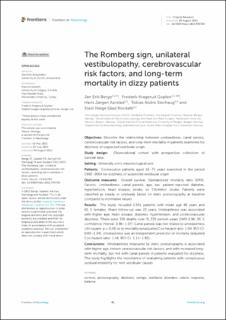| dc.contributor.author | Berge, Jan Erik | |
| dc.contributor.author | Goplen, Frederik Kragerud | |
| dc.contributor.author | Aarstad, Hans Jørgen | |
| dc.contributor.author | Storhaug, Tobias Andre | |
| dc.contributor.author | Nordahl, Stein Helge Glad | |
| dc.date.accessioned | 2022-09-30T12:37:15Z | |
| dc.date.available | 2022-09-30T12:37:15Z | |
| dc.date.created | 2022-09-15T13:32:06Z | |
| dc.date.issued | 2022 | |
| dc.identifier.issn | 1664-2295 | |
| dc.identifier.uri | https://hdl.handle.net/11250/3022937 | |
| dc.description.abstract | Objectives: Describe the relationship between unsteadiness, canal paresis, cerebrovascular risk factors, and long-term mortality in patients examined for dizziness of suspected vestibular origin.
Study design: Observational cohort with prospective collection of survival data.
Setting: University clinic neurotological unit.
Patients: Consecutive patients aged 18–75 years examined in the period 1992–2004 for dizziness of suspected vestibular origin.
Outcome measures: Overall survival. Standardized mortality ratio (SMR). Factors: Unsteadiness, canal paresis, age, sex, patient-reported diabetes, hypertension, heart disease, stroke, or TIA/minor stroke. Patients were classified as steady or unsteady based on static posturography at baseline compared to normative values.
Results: The study included 1,561 patients with mean age 48 years and 60 % females. Mean follow-up was 22 years. Unsteadiness was associated with higher age, heart disease, diabetes, hypertension, and cerebrovascular dizziness. There were 336 deaths over 31,335 person-years (SMR 0.96; 95 % confidence interval: 0.86–1.07). Canal paresis was not related to unsteadiness (chi square: p = 0.46) or to mortality (unadjusted Cox hazard ratio: 1.04, 95% CI: 0.80–1.34). Unsteadiness was an independent predictor of mortality (adjusted Cox hazard ratio: 1.44, 95% CI: 1.14–1.82).
Conclusions: Unsteadiness measured by static posturography is associated with higher age, known cerebrovascular risk factors, and with increased long-term mortality, but not with canal paresis in patients evaluated for dizziness. The study highlights the importance of evaluating patients with conspicuous postural instability for non-vestibular causes. | en_US |
| dc.language.iso | eng | en_US |
| dc.publisher | Frontiers | en_US |
| dc.rights | Navngivelse 4.0 Internasjonal | * |
| dc.rights.uri | http://creativecommons.org/licenses/by/4.0/deed.no | * |
| dc.title | The Romberg sign, unilateral vestibulopathy, cerebrovascular risk factors, and long-term mortality in dizzy patients | en_US |
| dc.type | Journal article | en_US |
| dc.type | Peer reviewed | en_US |
| dc.description.version | publishedVersion | en_US |
| dc.rights.holder | Copyright 2022 The Author(s) | en_US |
| dc.source.articlenumber | 945764 | en_US |
| cristin.ispublished | true | |
| cristin.fulltext | original | |
| cristin.qualitycode | 1 | |
| dc.identifier.doi | 10.3389/fneur.2022.945764 | |
| dc.identifier.cristin | 2052057 | |
| dc.source.journal | Frontiers in Neurology | en_US |
| dc.identifier.citation | Frontiers in Neurology. 2022, 13, 945764. | en_US |
| dc.source.volume | 13 | en_US |

